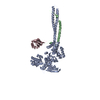+Search query
-Structure paper
| Title | CoREST Complex Inhibition Alters RNA Splicing to Promote Neoantigen Expression and Enhance Tumor Immunity. |
|---|---|
| Journal, issue, pages | bioRxiv, Year 2024 |
| Publish date | Dec 12, 2024 |
 Authors Authors | Robert J Fisher / Kihyun Park / Kwangwoon Lee / Katarina Pinjusic / Allison Vanasse / Christina S Ennis / Scott Ficcaro / Jarrod Marto / Stephanie Stransky / Joseph Duke-Cohan / Anupa Geethadevi / Eric Raabe / Simone Sidoli / Chad W Hicks / Derin B Keskin / Catherine J Wu / Philip A Cole / Rhoda M Alani |
| PubMed Abstract | Epigenetic complexes tightly regulate gene expression and colocalize with RNA splicing machinery; however, the consequences of these interactions are uncertain. Here, we identify unique interactions ...Epigenetic complexes tightly regulate gene expression and colocalize with RNA splicing machinery; however, the consequences of these interactions are uncertain. Here, we identify unique interactions of the CoREST repressor complex with RNA splicing factors and their functional consequences in tumorigenesis. Using mass spectrometry, in vivo binding assays, and cryo-EM we find that CoREST complex-splicing factor interactions are direct and perturbed by the CoREST complex inhibitor, corin, leading to extensive changes in RNA splicing in melanoma and other malignancies. Using predictive machine learning models and MHC IP-MS, we identify thousands of corin-induced neopeptides derived from unannotated splice sites which generate immunogenic splice-neoantigens. Furthermore, corin reactivates the response to immune checkpoint blockade and promotes dramatic expansion of cytotoxic T cells in an immune cold melanoma model. CoREST complex inhibition thus represents a unique therapeutic opportunity in cancer which creates tumor-associated neoantigens that enhance the immunogenicity of current therapeutics. STATEMENT OF SIGNIFICANCE: We identify a novel role of the CoREST transcriptional repressor complex in regulating pre-mRNA splicing and find that the small molecule inhibitor, corin, promotes alternative splicing events in cancer leading to neoantigen expression and T cell-mediated immunity. This represents a potential approach to promote immunoreactive neoantigen expression in immune-cold tumors. |
 External links External links |  bioRxiv / bioRxiv /  PubMed:39713349 / PubMed:39713349 /  PubMed Central PubMed Central |
| Methods | EM (single particle) |
| Resolution | 5.14 Å |
| Structure data | EMDB-47265, PDB-9dwu: |
| Source |
|
 Keywords Keywords | GENE REGULATION / RNA / splicing / melanoma / epigenetics |
 Movie
Movie Controller
Controller Structure viewers
Structure viewers About Yorodumi Papers
About Yorodumi Papers





 homo sapiens (human)
homo sapiens (human)